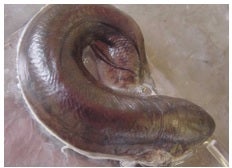During suspended animation, animals become inactive with absolutely no intake of food and water, and without urine or waste production, for an extended period. They enter into a state of torpor, slowing down the biological time in relation to the clock time. Suspended animation has long fascinated scientists because of its great application potentials in fields ranging from medicine to space travel. If suspended animation can be achieved in human, surgeons would have more time to operate on patients during critical moments when the blood circulation stops, and the dream of long distance space travel can be realized.

Protopterus annectens aestivating in a dried mucus cocoon [Image credit: IP YK]
Reference
Hiong KC, Ip YK, Wong WP, Chew SF. “Differential gene expression in the liver of the African lungfish, Protopterus annectens, after 6 months of aestivation in air or 1 day of arousal from 6 months of aestivation.” (2015) PLoS ONE 10(3): e0121224. doi:10.1371/journal.pone.0121224


